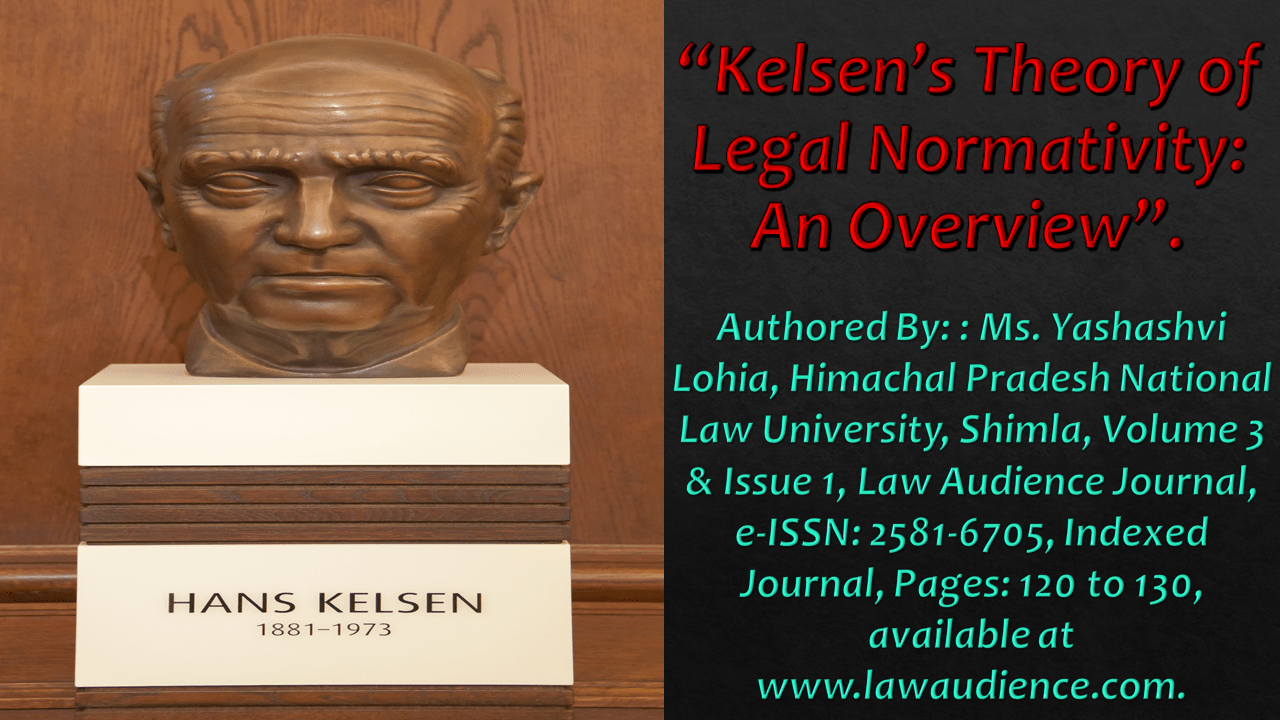Click here to download the full paper (PDF)
Authored By: Ms. Yashashvi Lohia, Himachal Pradesh National Law University, Shimla,
Click here for Copyright Policy.
I. INTRODUCTION:
Law is a set of rules and regulations which are enforced through the mechanism of social institutions to govern human behaviour. The term “law” has no fix definition which can be accepted all over the world. Law changes in the society as per the needs of the society. The system of law in turn affects and shape politics, economic, and society in various ways and on other hand it also serves as a mediator of relations between people. The subject of Jurisprudence originally initiated as a method controlling human behavior through the help of ideal laws or norms which are devised by some super-natural power for establishing justice and order in civilized society General jurisprudence can be broken into categories both by the type of question scholars seek to answer and by the theories of jurisprudence, or schools of thought.
The basic idea that “law is a normative system”, and that theory which deals with the questions pertaining to the nature of law must emphasize on its normativity is central/common to the works of Hans Kelsen, H. L. A. Hart, and many other legal theorists of the past century. Among various legal theorists Kelsen’s theory stands to be the most accepted version of normative theory.
II. CONCEPT OF LEGAL POSITIVISM:
Definition of legal positivism as per Black’s Law Dictionary is “Social perspective of a legal rule’s validity being authorized by law and socially accepted versus being based on natural or moral law. View of manmade law as posited by man for man, rather than being fair.[1]” The school of legal positivism primarily focuses to describe law by reference rather than moral criteria. legal positivism is standing on assumptions, beliefs and law in existence in present. And that should be kept away from the question whether such a law will be effective for future or not. According to Kelsen, ‘Law’ is “Order of human behaviour that react against certain regarded as detrimental against such orders of human behaviour, with a coercive act.” Kelsen has all other theories and came up with own theory i.e., “Pure Theory of Law”[2].
Kelsen in his theory believed that principle that law should uniform for everyone at all time and all places. Kelsen’s pure theory of law is based on the principle which is law and in toto devoid of other aspects like sociology, political science, etc., this theory is based on cause and effect. According to Kelsen, “it is the norm that directly or indirectly commands officials to apply force which control human conduct under certain circumstances, thus the theory of law is a theory of positive law”[3].
III. KELSEN’S PURE THEORY OF LAW:
Analytical Positivism was looked with a different view by Hans Kelsen in the 20th Century by propounding his new theory i.e., “Pure Theory of Law” As per the concept of Legal Positivism, Over the last few years there is a shift from metaphysical fact to facts whose basis is observation. Kelsen’s theory of law is called pure theory of law because theory of law must be free from legal disciplines. Kelsen was of the opinion that theory of law must be pure. Kelsen theory was in contradiction with the theory of Austin’s theory.
In this pure theory of law, Kelsen has given different meaning of the term law which is “Orders of human behavior that react against certain events, regarded as detrimental against such orders of human behavior, with a coercive act”[4].
III.I FEATURES OF KELSEN’S PURE THEORY OF LAW[5]:
- When Kelsen theory germinated its seed at that time that theory was seen as theory of positive law. This pure theory of law is given by Kelsen and it tells us about the hierarchy of norms.
- Kelsen further concluded that his order contains so many rules so it should be put in an order in a systematic way.
- Kelsen said that through his pure theory he tried to convert the law into science meaning that theory which could be easily understood by logic.
- Kelsen was of the view law should be seen as it is not as it ought to be.
- A norm is something which ought to happen when some other thing happens in relation to it.
- Pure theory of law should be same for all, at every place and every time. There should not be any change in law at different time and different places.
- Kelsen’s strict separation of law and morality is an integral part of his presentation of the Pure Theory of Law.
- There is a distinction between static and dynamic theory of law. Static theory talks about the hierarchy of norms which are related to one another and inferior and superior in respect with each other.
Kelsen’s has given concept of Basic norm and the concept of basic norm and it clearly gives the picture about unity of the legal System. All types of norms get their validity from single legal system. Basic norms are those norms which refers to any kind of specific situation which are established by custom or by any customary creation. The basic norm is a juristic thinking for the validity of order.
The main function of basic norm is to give power of creating law. 3 Main functions of Kelsen’s theory of basic norm which are fulfilled are
- Non-Reproductive explanation of legal validity
- Non-Reproductive explanation of normativity
- Systematic way of legal norms
The main aim of pure theory of law is law should be as it is not as it ought to be. As per analysis done by Kelsen, to consider that a legal norm is valid, only if that norm is created in accordance with higher valid norms. Kelsen did not agree with concept given by the Austin, for example, if a gangster commands us to hand over money to him that would not be binding because this is not legally valid. He has no power to ask such commands.
Kelsen has concluded that Austin has thought he could derive itself it is wrong. His main focus should be his command is to be issued. He also said that basic norm that it is “the final postulate on whose basis validity of all other legal norms depends”.
The main aim of pure theory is to raise consciousness that all other jurists are also doing in relation to the concept of object of enquiry[6].
IV. KELSEN’S THEORY OF NORMS:
Hans Kelsen is considered as one of the best jurists from the past. He was an Austrian jurist and he has done major developments in the field of law of positivist’s theory. Law is based on some kind of norms or rules or any Grundnorm on the basis of which any law or any statement is considered correct. A norm is not any kind of specific statement about its correctness so it is not capable of being true or false. A norm is not considered valid because it’s efficacious. When something is ought to occurred that can never be answered with certainty whether particular situation will occur or not. For example, if a mother says to her child, “you ought to go to school because your father has ordered it[7]” in this situation mere fact that father has ordered child to go to school is the only reason for validity of norm which is in question.
Mere command by one person of doing of an act is no reason for statement that person should behave according to the command given to them. The norm will not give us a picture of reality but it will back us to the situation from where it came into existence with a sense to investigate it later. Another example can be “you shall assist the fellowmen in need” is a valid norm because it’s believed that “you should love your neighbor it can be considered as valid norm because it is an ultimate norm whose validity is self-evident”. Another statement “you should lie whenever you think it’s useful for situation” that cannot be accepted as a valid norm because it’s not derived from any other type of norm nor it is self-evident. Kelsen believed the philosophy that on the “most peculiarity of law which regulates its own creation. Such kind of creation of legal norms is based on other legal norms”. According to Kelsen, the Grundnorm is a type of statement from which statement all other statement get approved or get its validity from.
Hans Kelsen has given concept of Basic Norm. He used this word Grundnorm in order to give meaning basic norm, order or rule. Kelsen did not believed the theory of command because it brings psychological element in this theory which in his view should be “pure”. As per Kelsen, norms are either nomostatic or nomodynamic. It will depend upon the relationship between the norms construed.
Nomostatic system that lower norms are derived from higher norms. Here, individuals are ought to behave in the manner as norms prescribed these norms are valid because they are derived from some other norms these norms are considered because they are either derived from some other norm or they are self-evident like you should not lie. You should not deceive these are the basic norms which should be believed and followed. It is important that various norms are deduced from one basic norm of truthfulness so all the norms related to static system must be inferred from general to particular and it’s known as static system.
Nomodynamic norms are those that are created as per the procedure defined by higher norms. The relationship between 2 kinds of norms lower and higher norms has no relation to substantive content. Nomodynamic system authorizes authorities of Higher norms to create the lower ones. Kelsen believed that nomodynamic norms are created through a specific procedure which are followed by the higher norms. He also believed that legal order must be understood in relation to hierarchy of norms, norms can be considered valid only when if it is created in procedure given by higher norms of same order. The norms of a dynamic system are created by individuals through their acts who has power to deduce norms from higher norms. Power of creating norms is delegated from higher authority to lower authority. Example: If there is a command by God or originates from authority which have its power from God are delegated by God.
Pure theory of law and Normative Theory of law are totally different from each other. Normative theory tells us about validity of law And Pure theory deals with efficacy. These both concepts are entirely different from each other. They both have no connection with each other but they have definite relation with each other.
IV.I LAW AS DYNAMIC SYSTEM OF NORMS[8]:
A norm is said to be a valid norm on the belief that it has been created according to a procedure followed to make rule and by virtue. The basic norm of a legal order is the postulated ultimate rule according to which the norms of this order are established and annulled, receive and lose their validity. One of the examples is Any man who manufactures or sells alcoholic should be punished it is valid legal norm if it is ant kind of legal order. The basic norm are those norms which are created by any custom or established by the courts, and such a norm has not been abolished the parliament or by any type of custom or by court The statement related to alcohol is not a valid legal norm.
Any such kind of norm which is created with the ultimate purpose that is determined by the basic norm. When any kind of norm is legal order, it cannot be deduced from basic norm as the legal norm. For example, help your neighbor whenever they need can be deduced from always love your neighbor. There are numerous ways to create norms. General norms can be deduced from customs, and individual norm scan be derived from administrative and judicial acts. Kelsen has said the main aim of pure theory is to raise the level of consciousness what all jurists are doing when, in conceptualizing their object of enquiry, they must understand the positive law as a valid system as a norm and not look them merely as factual contingencies. The basic norm is not created by following any kind of legal procedure or any other procedure. It’s created by a legal act it said valid because it is presumed it to be valid or correct. Legal norms are limited in time because of their validity and their validity depend upon the order of legislation. There are some norms which remain valid even after change of time the reason of being them valid is different. The main reason behind its validity is the revolution in the constitution of the court.
IV.II GRUNDNORM AND SANCTION:
Norms are the principles which are followed in relations to how persons behave. Kelsen believed that the legal norms are authorized by other legal norms. The legal norms which are created on basis of other legal norms that can be expressed in statute or any other kind of enactment. In accordance with the Hegelian theory of jurisprudence keelson has also tried to develop the concept of grundnorm. According to the Kelsen concept, general norms get their validity from basic or Grundnorm statements.
This concept bought into existence by Hans Kelsen. This word grundnorm was used to denote order, basic norm etc. Kelsen did not agree with concept of Austin of “law is a command backed by sanction” he believed that there should no idea of command because it brings psychological element and the theory should be pure. Kelsen believed that sanctions can be operated only if rule of law is in operation. He also believed that in order to make any rule valid it is not necessary to get it sanctioned. While Austin was of the view that Sanction brings validity to it.
Kelsen also believed that any legal order which begins with any kind of proposition a hierarchy of law is traceable, on other fundamental ought where the validity of norm get confirmed. He called it basic, grundnorm or fundamental norm. In his further study, Kelsen found that there must be some grundnorm in every legal order but it is not necessary that it will always be the same grundnorm. Grundnorm is nowhere defined in constitution it is a pre supposition expected by the theory that ought to follow it. Grundnorm doesn’t dictates it only provides validity to the norms derived from constitution. Kelsen also concluded that certain grundnorm is not valid on the reason behind people are obeying the law rather it should be conditioning that people are obeying the law that makes the grundnorm valid.
IV.III THE PRINCIPLE OF EFFECTIVENESS:
Kelsen in his study concluded that Grundnorm is not valid as compared to norms because these norms are obeyed easily by those to whom they are addressed. A norm is valid as well as effective both. For every norm to be valid it is necessary that legal order of every norm should be effective. Legal norms are based on the old legal order so it is not effective in current situations as a whole. The norms are considered valid because of the efficacy of the total order. The principle of legitimacy is restricted by principle of effectiveness. A legal order being effective is a condition but not a reason to make Grundnorm valid. The principle of effectiveness is adopted up to certain extent in national law. Under national law, legal norm can be valid only when it is depended upon effectiveness of legal order.
IV.IV THE “OUGHT” AND THE “IS”:
Legal norms are considered only when their order is found effective. Basic norm is valid only when it is determined by facts by which an order is created. It is not compulsory behavior of the people must be according to the order created. When anything happens in the society naturally in the law of nature it is not compulsory that should be in accordance with norms. The basic norm of social order without any exception would run in the manner: Men ought to behave as they actually behave, you ought to do what you actually do[9].
A normative order will become invalid when reality is not related to it till some extent. Any legal norm or order can be valid only depend upon its agreement is reality which should be effective. The term used the “ought” the “is” is to be used properly meaning thereby agreement must not exceed maximum nor fall to a certain level of minimum. Kelsen has done a small distinction between “ought” and “is”, “Ought” cannot be used in place of “is” and “is” cannot be used in place of “Ought”.[10] This dual use of ought and is helps us to know the reality. These terms is/ought was used earlier by Pufendorf. Pure theory of law by keyless appears on metalevel.
A term norm is a rule which clearly expresses that somebody ought to act in a particular way until unless somebody else really wants that person to act in that particular manner in some situation that way. “ought” is the subjective meaning of every act which is directed by will of another. Example: if a man asks another man for help the meaning of this situation is that the person who in a position to help should help him.
IV.V SUPERIORITY AND INFERIORITY OF NORMS:
A legal norm is considered valid only when it is created in way as determined by legal norm. The relationship between the legal norm and the basic norm is of higher and lower. Norm which is created on basis of another norm that norm is superior and norm on basis regulation that norm is inferior norm. the creation of lower one norm is determined by the higher one. It is the apex reason for considering whole legal order valid.
IV.VI HIERARCHY OF NORMS:
According to Kelsen, all kinds of norms come in existence through primary norms. Higher norms give the authority to lower norms. These norms get validity from higher norms. Primary Norms have 2 types of sanction;
- Transcendental;
- Social and Physical Sanctions;
Primary Norms are those norms which give the power to bodies to apply for sanctions. Citizens of this country are not authorized by primary norms so they are not important for bottom part of hierarchy of norms. Second level is the secondary norms meaning that these are that norms that are depended on some higher norms and these norms are either byelaws or enabling acts which are derived from primary norms. Finally at the top comes the Grundnorm or basic norm, these norms are those norms which makes the hierarchy of norms valid. It is presumed that if there is any kind of norm their validity must come from some higher norm till the culmination of Grundnorm. The validity of Grundnorm will depend upon proper applicability of lower norms. In this situation it is to be seen that primary norms are applied properly or not.
V. ANALYSIS OF KELSEN’S THEORY OF LAW:
Hans Kelsen in his theory has tried to convert the law into science. He wanted that theory should be understand able through logic. He was also of the view point that Grundnorm is ought to be obeyed. If constitution of country is a political and sociological document so in that case Grundnorm is not pure. Hans Kelsen also believed that law should be free from morality and he further tried to locate legal norms in idle of moral values and facts[11].
VI. CRITICISM OF KELSEN’S THEORY OF NORMS:
One of the main feature Pure theory of Kelsen is basic norm. it is one of the useless feature pure theory of Kelsen. His theory never gives a clear picture what kind of basic norm actually is, what is the use of that norm and where it can be used and how it is found. It clearly tells that this basic norm is not a norm of positive law. Kelsen believed that this basic norm is meta legal but in reality, it was legal norm.
Kelsen was of the view that the basic norm is based on basis of the legal order. Legal orders are affective and it is expected in the form that men should behave in accordance with the legal orders if that legal order are effective[12]. Kelsen gave the concept of basic norm in order to bring the unity in the legal system. It was later concluded there can be only one basic norm and on that basic norm all other norms are deduced. How all these things are related to the constitution is a question lying in front. There is no answer or lack of clarity of answer or Kelsen’ s thought on such issues. Kelsen theory was of the interpretation that legal norms exist in a situation which is fully effective and that system includes Hierarchy of valid Legal norms. Efficacy means effective and regular application of sanction through officials. Basic norm is the most problematic theory it has power to legitimate the revolutions and allow legitimacy claims because of reason of change in basic norm[13].
It was observed or found that Kelsen is an imperative theorist. Alike Austin, he is not only a positivists theorist. Criticism of both Kelsen and Austin can be the same. Imperative jurists are that jurists who have power to constitute sanctions because it becomes a necessary part of valid law. when there is large body of law there is no need of sanctions that are power conferring laws has ultimately proved that this view is incorrect. These imperative theorists of positivism emphasize on separation between law and morality. Morality such as sense of obligation and obeying of laws and rules can be found in citizens at many times irrespective of any kind of sanction.
VII. CONCLUSION:
Hans Kelsen propounded theory was found different from that of Austin. Hans Kelsen has defined norms in his theories. He found that all types of norms are connected with other another and the concept of basic norm is famously known as Grundnorm. All kinds of norms are deduced from the Grundnorm because Grundnorm is one of the highest norms in the hierarchy of norms.
No one has power to question about validity of Grundnorm because they are constitutional in its scope. In India constitution is the law of land. All laws derive their validity from Constitution of India. If any law is found unconstitutional it can be struck down easily. Hence, Kelsen’s idea was considered in today’s world.
Footnotes:
[1] Definition of LEGAL POSITIVISM (Black’s Law Dictionary), available at https://rb.gy/ha33uc.
[2] Kelsen, Hans, available at https://legal-dictionary.thefreedictionary.com/Kelsen%2C+Hans.
[3] HANS KELSEN, THE CONCEPT OF THE LEGAL ORDER, available at https://rb.gy/gotfay.
[4] Hans Kelsen: Pure Theory of Law.pg.15.
[5] Hans Kelsen: Pure Theory of Law. Pg19.
[6] supra note 4 at p. 74.
[7] Hans Kelsen, General Theory of Law and State Translated by Anders Wedberg.
[8] Hans Kelsen, General Theory of Law and State Translated by Anders Wedberg.
[9] Hans Kelsen, General Theory of Law and State Translated by Anders Wedberg.
[10] supra note 4 at p.32.
[11] supra note 4 at p.72.
[12] supra note 4 p.384.
[13] supra note 4 at p 263.
Cite this article as:
Ms. Yashashvi Lohia, Kelsen’s Theory of Legal Normativity: An Overview, Vol.3 & Issue 1, Law Audience Journal, Pages 120 to 130 (6th June 2021), available at https://www.lawaudience.com/kelsens-theory-of-legal-normativity-an-overview/.



